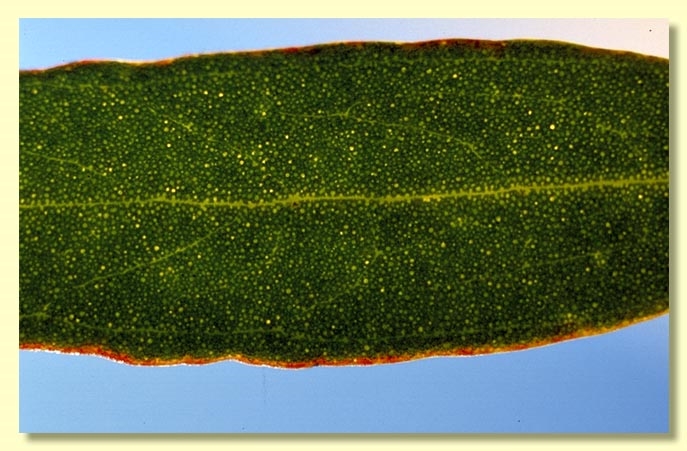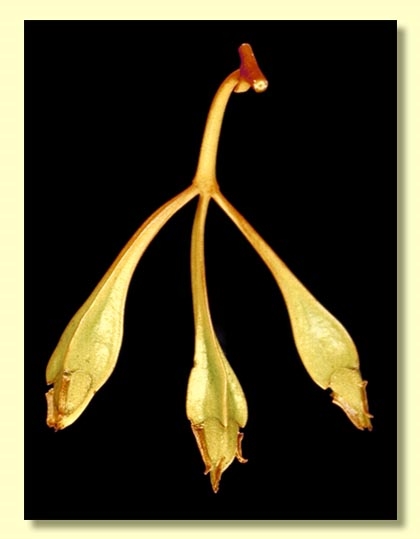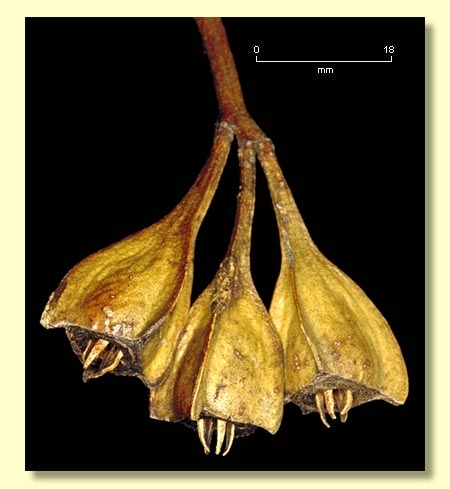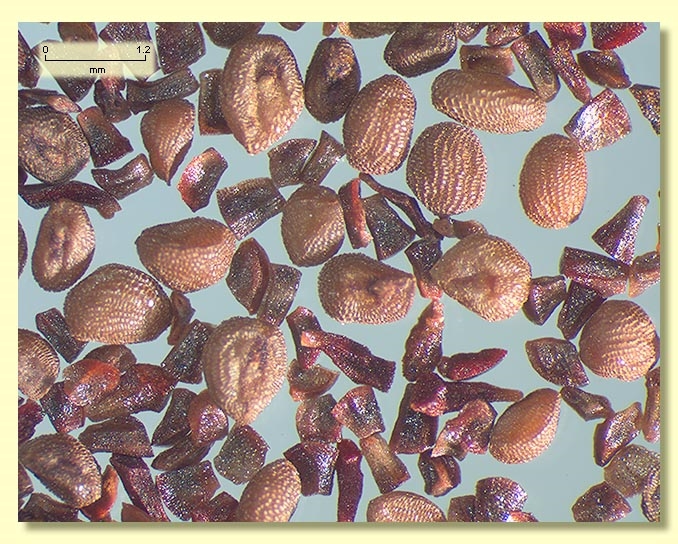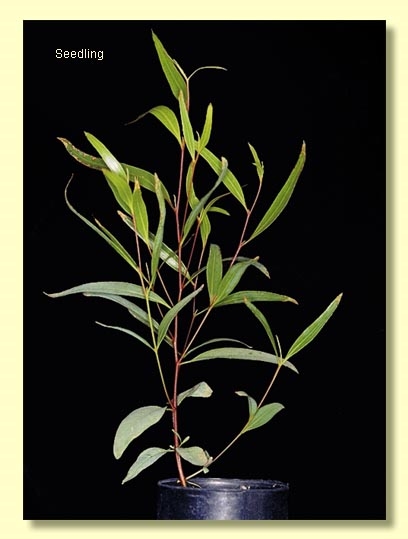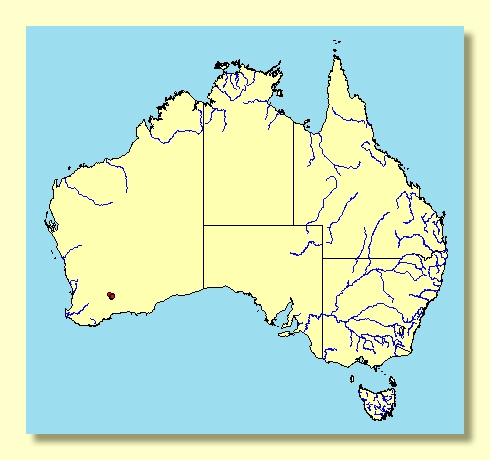Euclid - Online edition
Eucalyptus steedmanii
Eucalyptus | Symphyomyrtus | Bisectae | Glandulosae | Erectae | Abundae
T: Forrestania, S of Southern Cross, W.A., Feb. 1928, H.Steedman s.n.; holo: PERTH.
Bark smooth throughout, satiny, light pink to rich red-brown and grey.
Branchlets have oil glands in the pith.
Juvenile growth (coppice or field seedlings to 50 cm): not seen.
Adult leaves alternate, petioles 0.2–0.8 cm long; blade narowly oblong-elliptic, 3–8.5 cm long, 0.6–1.5 cm wide, base tapering to petiole, margin entire or distantly indented, apex rounded or pointed, concolorous, glossy, green, surface appearing "glazed", side-veins acute or obscure, reticulation and intramarginal vein obscure, oil glands numerous.
Inflorescence axillary unbranched, peduncles spreading to down-turned, 1.5–3.1 cm long, buds 3, pedicellate (pedicels 1.2–2 cm long). Mature buds broadly fusiform in outline and square in cross-section (2–3.2 cm long, 0.9–1.4 cm wide), outer operculum splitting as bud grows to appear as 4 persistent sepals on tips of hypanthium wings (i.e. the outer operculum is not shed and hence no operculum scar is formed), inner (petaline) operculum pyramidal, stamens erect, anthers oblong, versatile, dorsifixed, dehiscing by longitudinal slits, style long and straight on the conical ovary roof, stigma slightly dilated, locules 4, the placentae each with 4 vertical rows of ovules (rarely a few extra laterally placed ovules or even a complete fifth row). Flowers white.
Fruit pedicellate (pedicels 1–2 cm long), down-turned, obconical in outline, conspicuously 4-winged, 1.4–2 cm long, 1.3–2.2 cm wide (including wings), disc descending but obscured by persistent broad staminophore, valves 4, at rim level or slightly exserted.
Seeds brown, 0.8–2 mm long, ovoid or flattened-ovoid, dorsal surface clearly and shallowly reticulate, hilum ventral.
Cultivated seedlings (measured at node 10): cotyledons Y-shaped (bisected); stems rounded in cross-section, usually with scattered warts; leaves shortly petiolate, opposite for 4 or 5 nodes then alternate, narrowly lanceolate to linear, 6.5–10.5 cm long, 0.8–2 cm wide, dull, green until ca node 8 or 9 then becoming glossy. Lamina (underside) and midrib of lower leaves have sparse warts that make them feel slightly rough when fresh.
Flowering time January, February, March.
A striking, small tree when used in horticulture.
A mallet endemic to Western Australia restricted to two sites in the Ironcap Range east of Hyden. The bark is smooth and the adult leaves olive green to green with numerous oil glands obscuring the venation.
Eucalyptus steedmanii is a somewhat atypical species in Eucalyptus subgenus Symphyomyrtus section Bisectae subsection Glandulosae because the outer operculum of the buds does not shed leaving an operculum scar (see above); however, the cotyledons are bisected and branchlets have oil glands in the pith. E. steedmanii belongs to a subgroup further characterised by having buds with erect stamens, series Erectae, and is distinguished from most other species in this group by the four-winged appearance of the relatively large buds and fruit and by the pyramidal inner operculum.
E. steedmanii is unlikely to be confused with any other species. Its closest relative, E. mimica subsp. mimica, shares the unusual outer operculum character but has smaller buds and fruits that, whilst square in cross-section, are not winged. E. mimica subsp. continens differs further by retaining its outer operculum intact (not split into sepals) until about flowering time when it is scarious and thin, covering a slightly warty inner operculum. E. steedmanii was "lost" for many years after its initial discovery and naming, but became a well-known cultivated tree from original seed samplings. It was rediscovered in the 1970s at the type locality and later found at another site to the north on the North Ironcap Track.
Eucalyptus steedmanii is listed as "Vulnerable" under the Australian Government Environment Protection and Biodiversity Conservation Act 1999 (EPBC Act). Further information may be found at this web address:
http://www.environment.gov.au/cgi-bin/sprat/public/sprat.pl



